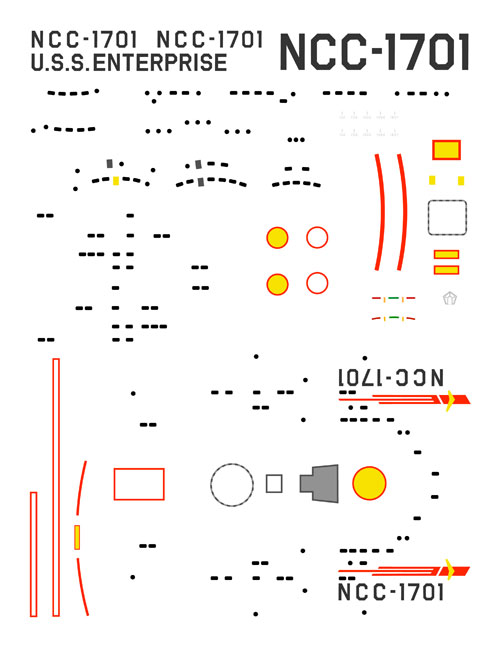^^^ I think the idea behind that was to have the saucer be its own aero-brake if it had to separate from the neck and make a forced landing on a planet with an atmosphere. Don't know if it would actually work, though. I somehow remember someone doing a simulator on the saucer design to see how it would react in an uncontrolled descent, and I think it started tumbling as the resistance that was supposed to build up under the saucer wound up getting trapped in small, uneven, convection currents, pushing subsequent air out of the way, making it fall almost as fast as if it didn't have the inner curve. That was a looooong time ago, though, and I'm probably mis-remembering some of it.
-
Welcome! The TrekBBS is the number one place to chat about Star Trek with like-minded fans.
If you are not already a member then please register an account and join in the discussion!
You are using an out of date browser. It may not display this or other websites correctly.
You should upgrade or use an alternative browser.
You should upgrade or use an alternative browser.
Phase II Enterprise Study Model
- Thread starter Shaw
- Start date
- Status
- Not open for further replies.
The surprising aspect of all this was that Jefferies was doing all this in his spare time while working as art director for Little House on the Prairie. Many of the plans of the Phase II Enterprise were drawn in his hotel room in the evenings while working on location. And the attention to detail isn't just surprising when looking at this work in the context of the Phase II production (and his lack of a solid connection to it), what makes the work he did so interesting (to me) is that it acts as a Rosetta Stone to how he viewed the Enterprise during TOS.But this sort of detail isn't surprising when you consider that Jefferies had the bottom of the saucer go from flat, to curving upwards, and then curving into a bowl shape that bulges from the bottom of the saucer section.
I've pretty much finished the designing of the decals I'll be using on this model. Hopefully I'll be able to sent those off for printing in the near future.
The lettering is a trace of the original TOS decal sheet because it was also used on the 33 inch model which was available as a reference during Phase II (and wasn't lost until it was loan to Robert Abel and Associates during TMP).
Another cool (at least to me) aspect about this study model is that it is 1/500 scale (Jefferies' Phase II Enterprise was to be about 950 feet long), making it the same scale as my last 33 inch TOS Enterprise model. So it is quite interesting to have them sitting next to each other.
The surprising aspect of all this was that Jefferies was doing all this in his spare time while working as art director for Little House on the Prairie. Many of the plans of the Phase II Enterprise were drawn in his hotel room in the evenings while working on location. And the attention to detail isn't just surprising when looking at this work in the context of the Phase II production (and his lack of a solid connection to it), what makes the work he did so interesting (to me) is that it acts as a Rosetta Stone to how he viewed the Enterprise during TOS.But this sort of detail isn't surprising when you consider that Jefferies had the bottom of the saucer go from flat, to curving upwards, and then curving into a bowl shape that bulges from the bottom of the saucer section.
Maybe it might seem difficult under those circumstances, and indeed, perhaps it was indeed difficult, but think about it: Jefferies was an artist. And if he was anything like me, he loved art, and enjoyed sketching. And if he was really like me, he also enjoyed sketching flying vehicles. So all of those sketches, and all of the associated detail, probably came out pretty easily, even if it did consume a lot of Jefferies's spare time, at the time in question.
It is not surprising to me that he sketched in his spare time. In fact, if not for the fact I had the Internet, I'd probably be sketching right now, rather than looking at other peoples's sci-fi artwork, playing video games, or watching online videos, which are really the only other things I love more than sketching.
I finally got some time together to start in on the box I'll use for making the nacelle molds...
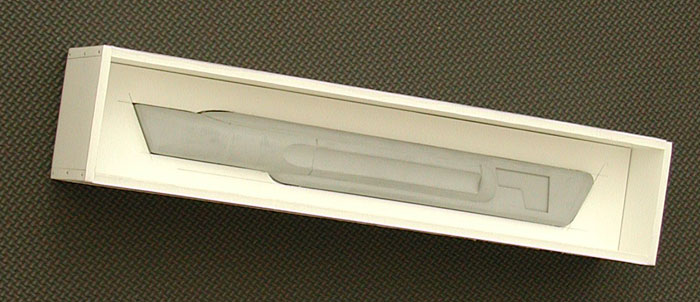
When I'm ready I'll fill the remaining gaps around the nacelle with clay and pour the rubber. When it sets I'll remove the center board (and clay) around the nacelle and pour the other side. Even though these are going to be used to make two different sides of each nacelle, I'd still like to get as straight a seam to rejoin the sides as possible.
This diagram shows how I plan on building the nacelles.
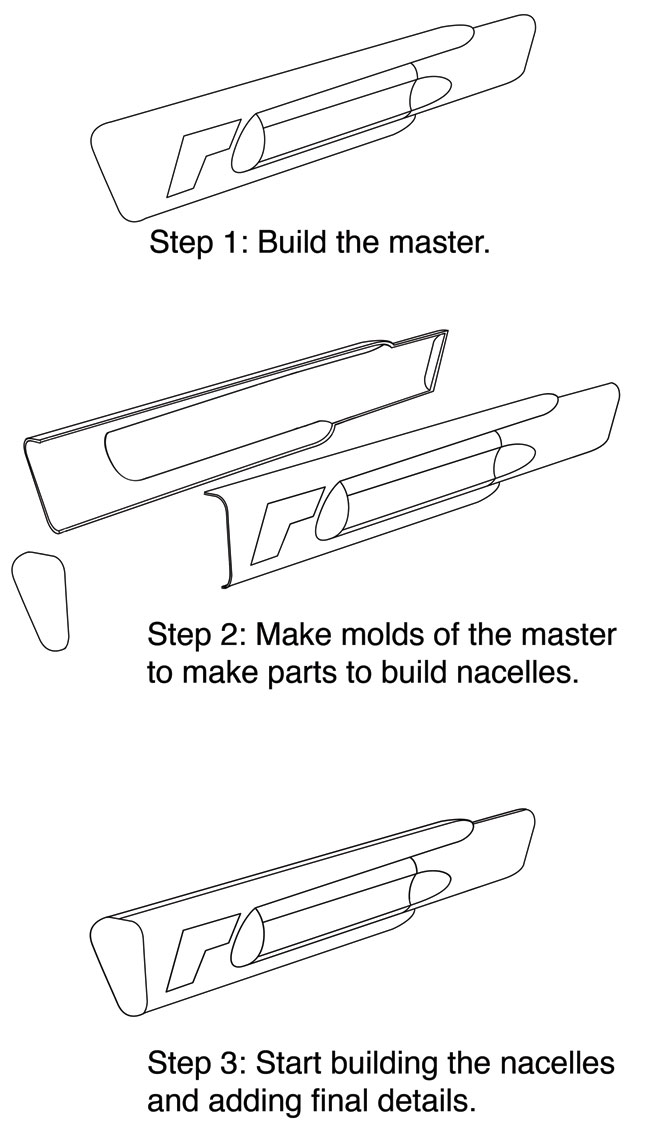

When I'm ready I'll fill the remaining gaps around the nacelle with clay and pour the rubber. When it sets I'll remove the center board (and clay) around the nacelle and pour the other side. Even though these are going to be used to make two different sides of each nacelle, I'd still like to get as straight a seam to rejoin the sides as possible.
This diagram shows how I plan on building the nacelles.

Awesome... just awesome.
Since you asked for it, here it is (Andrew Probert's sketch for the testbed USS Yorktown).
Andrew said he had a colored version of it but would have to look for it, so hopefully this one will do for the moment.
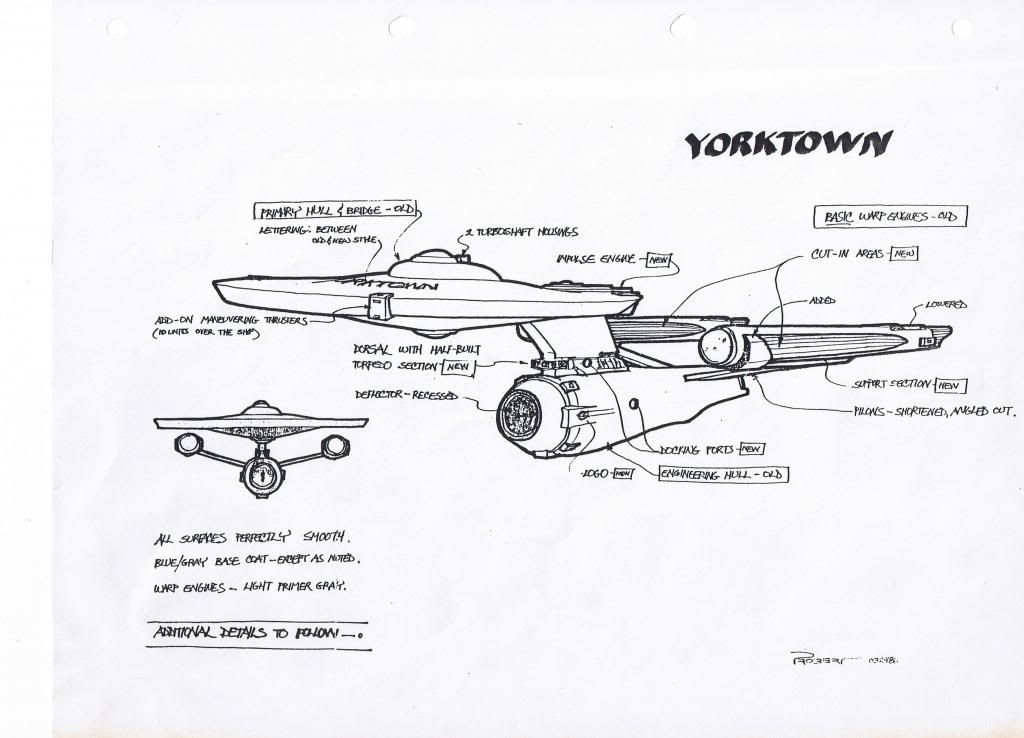
Love that take on the uprated Constitution design! Have you seen these renderings of it: http://www.trekbbs.com/showpost.php?p=5006931&postcount=2
Nice design, although kind of curious about the functional choice to place the nacelles below the primary hull. It's almost like they were planning on refitting this thing later as a dreadnaught.
That's a pretty sweet drawing.
I spent some time working on the weapon assembly this week. The parts are still quite rough, and the main thing I've been focusing on is getting them to fit the contours of the model. Right now it is made up of three parts... the assembly body, and the upper and lower supports. The lower support was the hardest part to build because it had to match the secondary hull.
Here is a few shots of the parts put in place, they aren't glued together yet, they are just set in place to make sure they all fit together.
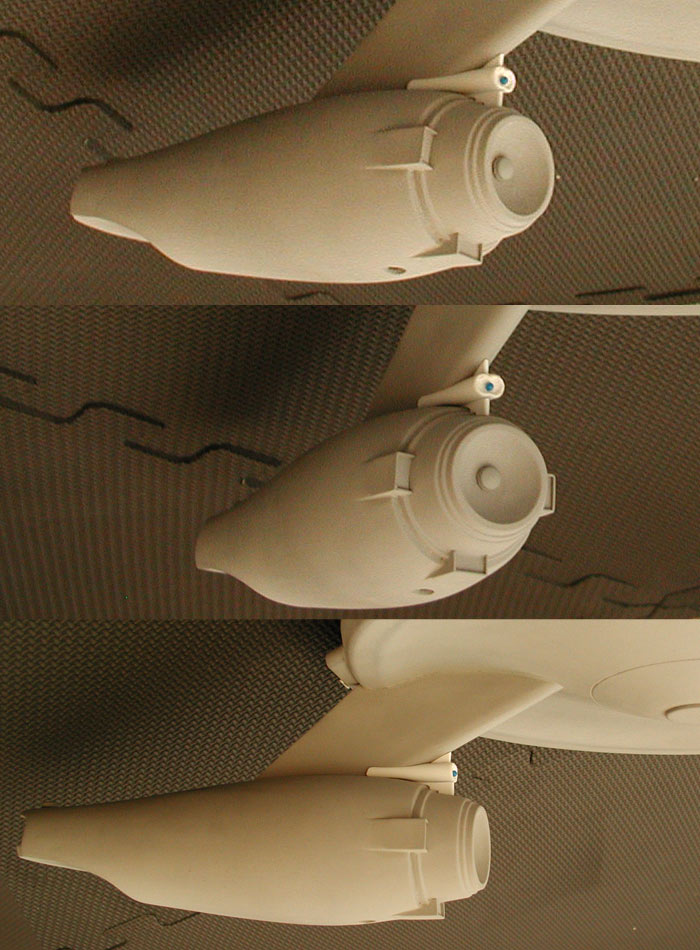
I think I put off making the weapon assembly for as long as I have because I felt it takes away from the elegant lines of the design, but now that I have the parts in place it isn't as bad as I thought it was going to be.
Here is a few shots of the parts put in place, they aren't glued together yet, they are just set in place to make sure they all fit together.

I think I put off making the weapon assembly for as long as I have because I felt it takes away from the elegant lines of the design, but now that I have the parts in place it isn't as bad as I thought it was going to be.
This is definitely coming along very, very nicely  Can´t wait to see more!
Can´t wait to see more!
 Can´t wait to see more!
Can´t wait to see more!I always thought this was the Phase II enterprise
http://collectingthefuture.blogspot.com/2010/02/sttmp-read-along-adventure.html
I have this book at my Dad's unopened. I noticed that it wasnt the Eneteprise refit, and always assumed that it was the phase II ship. But it seems it is not...then what is it?
Btw, great job on the construction of that study model. I wish I knew how to build models from scratch...
http://collectingthefuture.blogspot.com/2010/02/sttmp-read-along-adventure.html
I have this book at my Dad's unopened. I noticed that it wasnt the Eneteprise refit, and always assumed that it was the phase II ship. But it seems it is not...then what is it?
Btw, great job on the construction of that study model. I wish I knew how to build models from scratch...
Thanks!
That is the TMP model as originally finished. The model was damaged (bridge/B/C deck structure) and the idea of self illumination was added just before the beginning of effects shooting.
Some of the other changes included placement of the decals and the elimination of a bunch of red lines (racing stripes) all over the model. This is a quick-n-dirty diagram of what the striping looked like from the bottom of the primary hull…
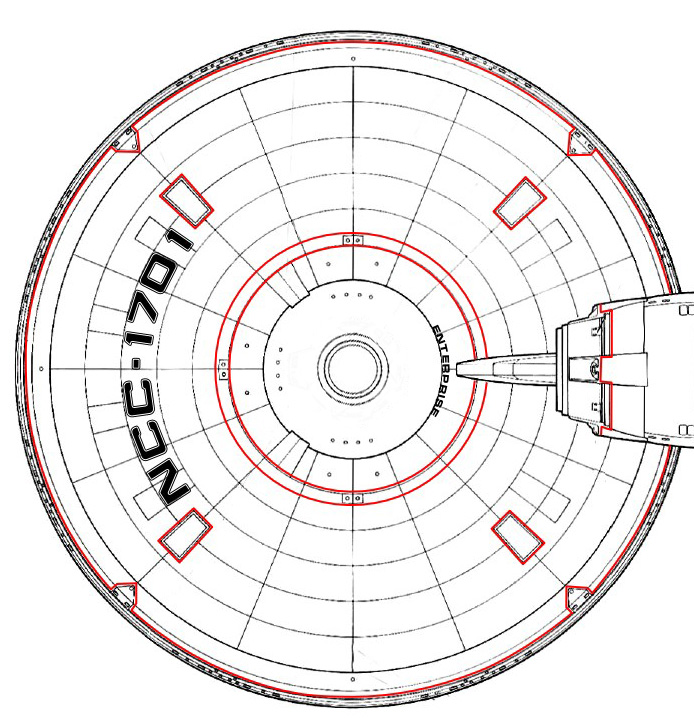
That is the TMP model as originally finished. The model was damaged (bridge/B/C deck structure) and the idea of self illumination was added just before the beginning of effects shooting.
Some of the other changes included placement of the decals and the elimination of a bunch of red lines (racing stripes) all over the model. This is a quick-n-dirty diagram of what the striping looked like from the bottom of the primary hull…

IIRC, the surface details and lighting changed when Doug Trumbull was pulled onto the project late. There was some issue with the early VFX shots (from Apogee maybe? Can't remember) and he was brought in to make some adjustments. The post-Phase II/pre-TMP design showed up in a lot of early promotional artwork and merchandise. I think I may still have the jigsaw puzzle with that design, and the toy with removable components also was of the pre-TMP design. Looking at it side-to-side with the AMT-ERTL kit, which was in roughly the same scale, it always befuddled me as a kid why the two different layouts. Artwork I could understand - even then - I got that there was always a certain level of artistic interpretation and stylized deviation in painted works. But when my 8-year-old brain saw two real-life models, both nearly identical and yet very blatantly different, it really furrowed my brow back then. I guess I was as OCD about ship design as a child as I still am today. 

That is the TMP model as originally finished. The model was damaged (bridge/B/C deck structure)....
Interesting. I've never heard this tidbit. I'd like to know more!
Okay, so what I can gather (including conversations with some people and published interviews with others) this seems to be how this unfolded…That is the TMP model as originally finished. The model was damaged (bridge/B/C deck structure)....
Interesting. I've never heard this tidbit. I'd like to know more!
In December of 1977 it was officially released to the production people working on Star Trek Phase II that the series was going to be reworked into a movie. And that Robert Abel and Associates would be the lead for special effects. I think that Magicam may have known about this even before everyone else was let in. Meetings were set up for Abel, Richard Taylor, Roddenberry and some others to review what had been produced so far for Phase II and to see what could be used in the movie. The meeting for miniatures took place at Magicam's workshop.
Here is the thing, I've seen two sets of photos from this inspection… and they don't include the same people or models. Taylor seemed to be at the shop earlier looking over Magicam's work but is absent from images later when Brick Price and Don Loos brought over elements of the Phase II Enterprise and assembled it for inspection. In later interviews Taylor described a two and a half to three foot model that wasn't designed to be lit with not much surface details. The Phase II Enterprise was over five feet long and was intended to be fully lit. I don't think Taylor actually ever saw the Phase II Enterprise. What he seems to be describing was the 33 inch TOS Enterprise that was being used as a reference for Phase II.
Why does this matter? The Phase II Enterprise model was deemed unusable because it was too small to show up nicely on the large screen. A larger (eight foot) model was decided on and Magicam was given the project rather than Brick Price and Don Loos. This was important to Magicam because they were just starting out and the TMP Enterprise would be a nice boost to their resume.
Taylor wasn't a fan of the Enterprise design, but Roddenberry was adamant about keeping the overall design. Taylor enlisted Andrew Probert to help him redesign the Enterprise, using Jefferies plans as a starting point. This is funny in that Taylor has consistently taken credit for moving the nacelle design from the TOS cylinders to the TMP "rectilinear" style, seeming to have forgotten that his nacelle design was actually a modification of Jefferies' Phase II nacelles.
Here is a comparison of the Taylor/Probert Enterprise next to the Jefferies' Enterprise…
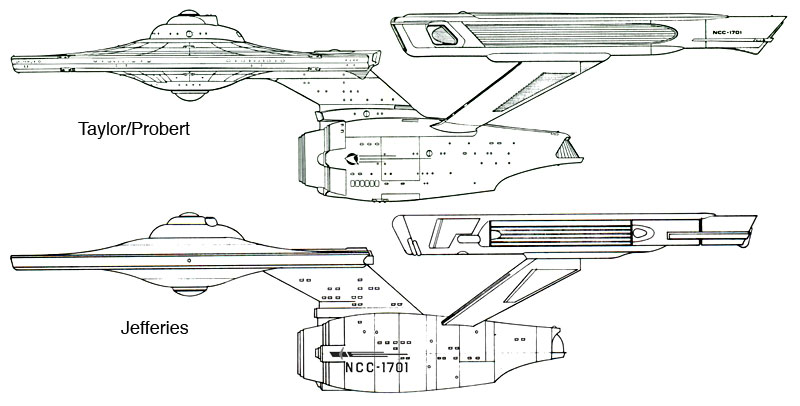
This is a more honest representation of their contributions to the design than what Taylor usually shows (which is a comparison with Franz Joseph's TOS Enterprise plans).
At any rate, these new plans were what Magicam used to build the TMP Enterprise. The model was built and test shots were taken. This was when more shuffling came about and Abel and Taylor found themselves no longer part of the production.
So two events occurred, Douglas Trumbull took over and it rained in Southern California. The idea was put forward for the Enterprise to have self illumination spot lights which was going to require some changes to the model. Unfortunately the model, while in storage, found itself under a leak in the roof that wrecked the bridge/B/C deck structure and damaged the upper surface of the primary hull. Rather than rebuild it the way it was, they took this opportunity to redesign it into what we eventually saw on screen.
But yes, the damage was extensive enough that large areas of the model needed to be repainted and one of the things that was not included in the refinishing was the racing stripes. The only part of those that made it to the final version were the lines on the upper dorsal and part of the lines around the RCS mounts on the primary hull.
Slightly off topic, Taylor's description of the 33 inch TOS Enterprise model confirms other accounts that the model was loaned to Robert Abel and Associates in 1978. Unfortunately it also shows that the people working there had no idea what it was or how it might have been valuable. And with Taylor's attitude of "scrap everything and start over", it isn't any wonder that when Roddenberry contacted Abel to get the model back they weren't able to find it.
I'm not saying that Taylor destroyed the 33 inch Enterprise, but if his attitude was indicative of those working at Robert Abel and Associates, it isn't surprising that that was the mission she never returned from.

WOW. Thank goodness he didnt loan them the 12ft miniature. Speaking of which, it doesn't look like itself anymore. There are lines on the ventral saucer that didnt show up on the show. Also despite being behind glass, it lots like the 12ft tos miniature is deterioting and color fading badly.
- Status
- Not open for further replies.
Similar threads
- Replies
- 25
- Views
- 9K
- Replies
- 87
- Views
- 20K
If you are not already a member then please register an account and join in the discussion!

